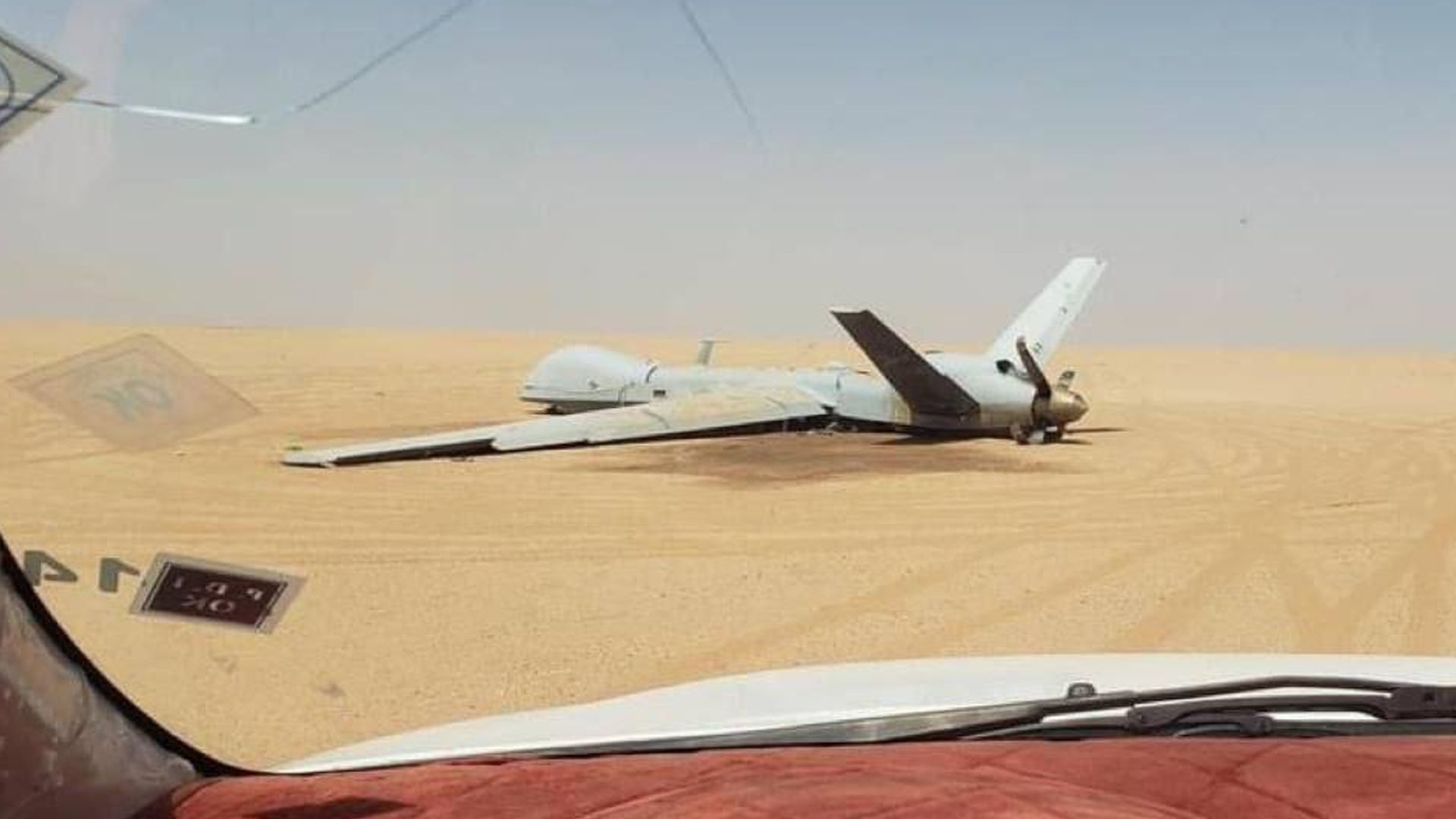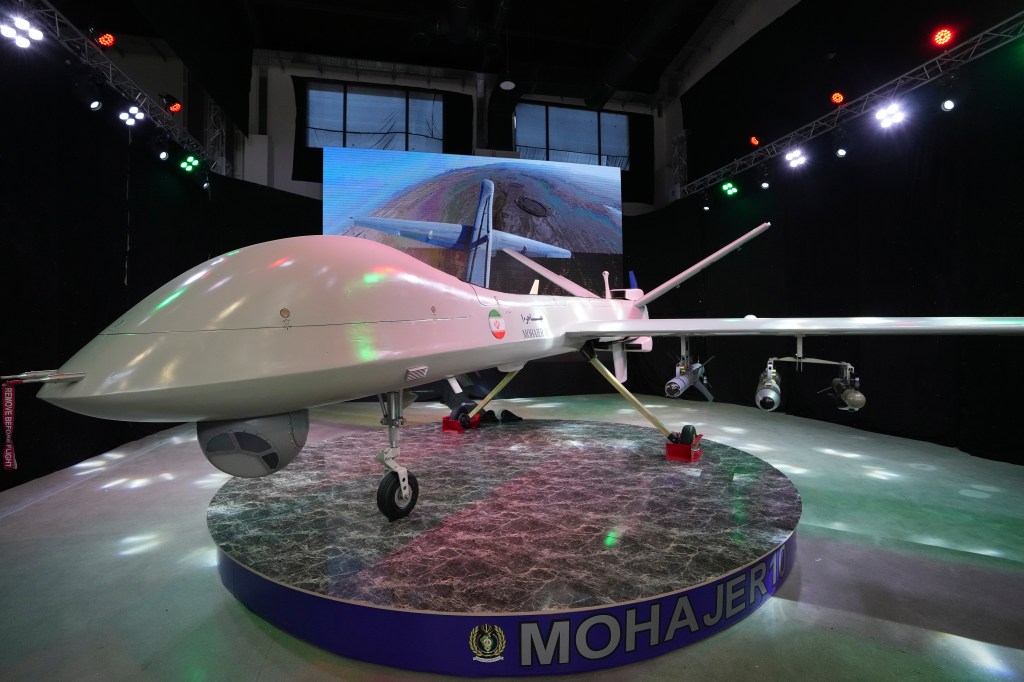
Since October, Houthi militants in Yemen have shot down five U.S.-operated MQ-9 Reapers. These unmanned aerial systems, larger than some planes, are primarily used for intelligence, surveillance and reconnaissance (ISR), but they can also carry munitions, such as Hellfire missiles.
Media Landscape
See how news outlets across the political spectrum are covering this story. Learn moreBias Distribution
Left
Right
Untracked Bias
Straight Arrow News’ Ryan Robertson spoke to Jonathon Molik, a U.S. intelligence officer with 30 years of experience.
“Is that alarming to you, as an intelligence officer, to hear so many Reapers going down and being recovered?” Robertson asked.

Download the SAN app today to stay up-to-date with Unbiased. Straight Facts™.
Point phone camera here
“You know, that’s a good question,” Molik said, “I think, first of all, what it does is it helps to detail what the difference is between counterinsurgency operations and a conventional fight.”
Molik noted that Reapers first started flying during the U.S. wars in Iraq and Afghanistan, when coalition forces enjoyed total air superiority.
“We had the ability to fly any assets — fixed-wing UAS or remotely piloted aircraft — with impunity, really,” he said.
Today, the Houthis are using Iranian-supplied SA-6 air defense missiles, which are finally proving capable of downing 20+ year old U.S. technology. Molik suggested that this might be why the public is not seeing any U.S. military attempts to scuttle the tech before it falls into enemy hands.
According to Molik, the military would likely move to destroy the hardware if it carried technology the enemy doesn’t already know about.
“It all really depends on which capabilities are on the device or on the asset at the time,” he said. “Some of these capabilities are widely known. They have electro-optical sensors, which basically just take images and video, and synthetic aperture radar, which was developed in the 1950s but is becoming more capable now. Those types of technologies are not something we’re all too concerned about. Pretty much everybody knows that we use those.”
Molik suggested the Reapers flying over Yemen right now are likely some of the more basic models, which are already being copied by the North Koreans and Iranians.

In 2023, the Russians were able to force a Reaper into the Black Sea after a Russian fighter jet collided with the drone. That particular craft was running some advanced software, which the Defense Department was able to wipe remotely before the Reaper crashed.
After more than 20 years of gathering intelligence mostly unimpeded, Molik said the Reaper needs to adapt — and it is.
“[The military is] trying to find the best way to integrate these assets within a whole system of technologies,” he said. “They’re adding communications packages, advanced radar defense capabilities. They want to see these MQ-9 Reapers or the Grey Eagle, the Army version, the MQ-1C, integrated into a greater network of assets flying around at the same time.”
One example of the Reaper’s adaptation is pairing it with an Apache attack helicopter, part of a concept called “Manned-Unmanned Teaming.” Molik said the Apache pilot could tell the Reaper to perform duties the helicopter can’t, acting as a more direct force multiplier.
Unbiased news.
Directly to your inbox. Free!
Learn more about our emails. Unsubscribe anytime.
By entering your email, you agree to the Terms & Conditions and acknowledge the Privacy Policy.
“That’s what we’re going to see going forward into the future,” he said. “And those are the types of capabilities and technologies you won’t see on the Reapers flying over Yemen right now because they don’t need them.”
Clearly, Reapers are not going away anytime soon. Molik said they’re too capable a platform to ditch, so they’ll be upgraded and integrated accordingly, like many other highly capable systems in the Defense Department’s inventory, such as the Bradley IFV and the B-52. (Long live the Buff!)
It’s also important to note that it’s not just the United States that will be using Reapers for years to come, other countries will too. In fact, India just bought 31 Reapers from the U.S. for just under $4 billion.
SINCE OCTOBER, HOUTHI MILITANTS IN YEMEN SHOT DOWN FIVE U.S. OPERATED MQ-9 REAPERS. BIGGER THAN SOME PLANES, REAPERS ARE UNMANNED AERIAL SYSTEMS PRIMARILY USED FOR ISR. THAT’S INTELLIGENCE, SURVEILLANCE, AND RECONNAISSANCE, BUT THEY DO HAVE THE ABILITY TO CARRY SOME MUNITIONS LIKE HELLFIRE MISSILES.
Ryan: Is that alarming to you as an intelligence officer to hear so many Reapers going down and being recovered?
Molik: You know, that’s a good question. I think, first of all, what it does is it helps to detail what the difference is between counterinsurgency operations and the conventional fight.
JONATHON MOLIK IS A U.S. INTELLIGENCE OFFICER WITH 30 YEARS OF EXPERIENCE. HE SAYS REAPERS FIRST STARTED FLYING DURING THE U.S. WARS IN IRAQ AND AFGHANISTAN, WHEN COALITION FORCES ENJOYED TOTAL AIR SUPERIORITY.
Molik: We had the ability to fly any assets, fixed-wing UAS or remotely piloted aircraft, as we call them now, with impunity really.
TODAY, THE HOUTHIS ARE USING IRANIAN SUPPLIED SA-6 AIR DEFENSE MISSILES, WHICH ARE FINALLY PROVING CAPABLE OF DOWNING 20+ YEAR OLD U.S. TECHNOLOGY.
AND MOLIK SAYS MAYBE THAT’S WHY WE’RE ALSO NOT SEEING SOMETHING ELSE WITH THE DOWNING OF THESE REAPERS: ANY ATTEMPTS BY THE U.S. MILITARY TO SCUTTLE THE TECH BEFORE IT FALLS INTO ENEMY HANDS.
ACCORDING TO MOLIK, THE MILITARY WOULD LIKELY MOVE TO DESTROY THE HARDWARE IF IT CARRIED TECHNOLOGY THE ENEMY DOESN’T ALREADY KNOW ABOUT.
Molik: It all really depends on which capabilities are on the device or on the asset at the time. And some of these capabilities are widely known. They have electro-optical sensors where we basically just take images and video. It has synthetic aperture radar, which is something that was even developed in the ‘50s, but it’s becoming a little bit more capable now. Those types of technologies, if you will, are not something that we’re all too concerned about. Pretty much everybody knows that we use those.
MOLIK SAYS THE REAPERS FLYING OVER YEMEN RIGHT NOW ARE LIKELY SOME OF THE MORE BASIC MODELS, WHICH ARE ALREADY BEING COPIED BY THE NORTH KOREANS AND IRANIANS.
LAST YEAR, THE RUSSIANS WERE ABLE TO FORCE A REAPER INTO THE BLACK SEA AFTER A RUSSIAN FIGHTER JET COLLIDED WITH THE DRONE. THAT PARTICULAR CRAFT WAS RUNNING SOME ADVANCED SOFTWARE WHICH THE DOD WAS ABLE TO WIPE REMOTELY BEFORE THE REAPER CRASHED.
SO, AFTER 20+ YEARS OF GATHERING INTEL MOSTLY UNABATED, MOLIK SAYS THE REAPER NEEDS TO ADAPT. AND IT IS.
Molik: They’re trying to find the best way to integrate these assets within a whole system of Air Force technologies. And I can say that that is the case. They’re adding communications packages, they’re adding advanced radar defense capabilities. And what they want to see is, as you had mentioned, these MQ-9 Reapers or the Grey Eagle, which is the Army version, the MQ-1C, into a greater network of assets that are flying around at the same time.
ONE EXAMPLE OF THE REAPER’S ADAPTATION: PAIRING IT WITH AN APACHE ATTACK HELICOPTER. PART OF A CONCEPT CALLED ‘MANNED-UNMANNED TEAMING.’ MOLIK SAYS THE APACHE PILOT COULD TELL THE REAPER TO PERFORM DUTIES THE HELICOPTER CAN’T–ACTING AS A MORE DIRECT FORCE-MULTIPLIER
Molik: That’s what we’re going to see going forward into the future. And those are the type of capabilities and technologies you won’t see on the Reapers that are flying over Yemen right now, because they don’t need them.
SO REAPERS ARE DEFINITELY NOT GOING AWAY ANYTIME SOON. MOLIK SAYS THEY’RE JUST TOO CAPABLE A PLATFORM TO DITCH. SO, THEY’LL BE UPGRADED AND INTEGRATED ACCORDINGLY–LIKE MANY OF THE OTHER HIGHLY CAPABLE SYSTEMS IN THE DOD’S INVENTORY. THINK THE BRADLEY IFV, OR THE B-52. LONG LIVE THE BUFF.
ALSO, IT’S IMPORTANT TO NOTE IT’S NOT JUST THE UNITED STATES THAT WILL BE USING REAPERS FOR YEARS TO COME. OTHER COUNTRIES ARE TOO. IN FACT, INDIA JUST BOUGHT 31 REAPERS FROM THE U.S. FOR JUST UNDER $4 BILLION DOLLARS.
FOR MORE OF OUR REPORTING ABOUT THE LATEST U.S. WEAPONS TECH, OR FOR MORE ON THE CONFLICT WITH THE HOUTHIS, DOWNLOAD THE STRAIGHT ARROW NEWS APP TODAY OR VISIT US AT SAN.COM.
FOR STRAIGHT ARROW NEWS, I’M RYAN ROBERTSON.
Media Landscape
See how news outlets across the political spectrum are covering this story. Learn moreBias Distribution
Left
Right
Untracked Bias
Straight to your inbox.
By entering your email, you agree to the Terms & Conditions and acknowledge the Privacy Policy.
MOST POPULAR
-
 Reuters
Reuters
New coronavirus discovered in bats similar to COVID-19
Read6 hrs ago -
 Getty Images
Getty Images
DOJ investigating UnitedHealth over Medicare Advantage billing: Report
Read9 hrs ago -
 Reuters
Reuters
Diddy’s defense attorney abruptly requests withdrawal from case
Watch 1:4022 hrs ago -
 Getty Images
Getty Images
Judge allows CNN lawsuit potentially worth billions to continue
ReadYesterday




